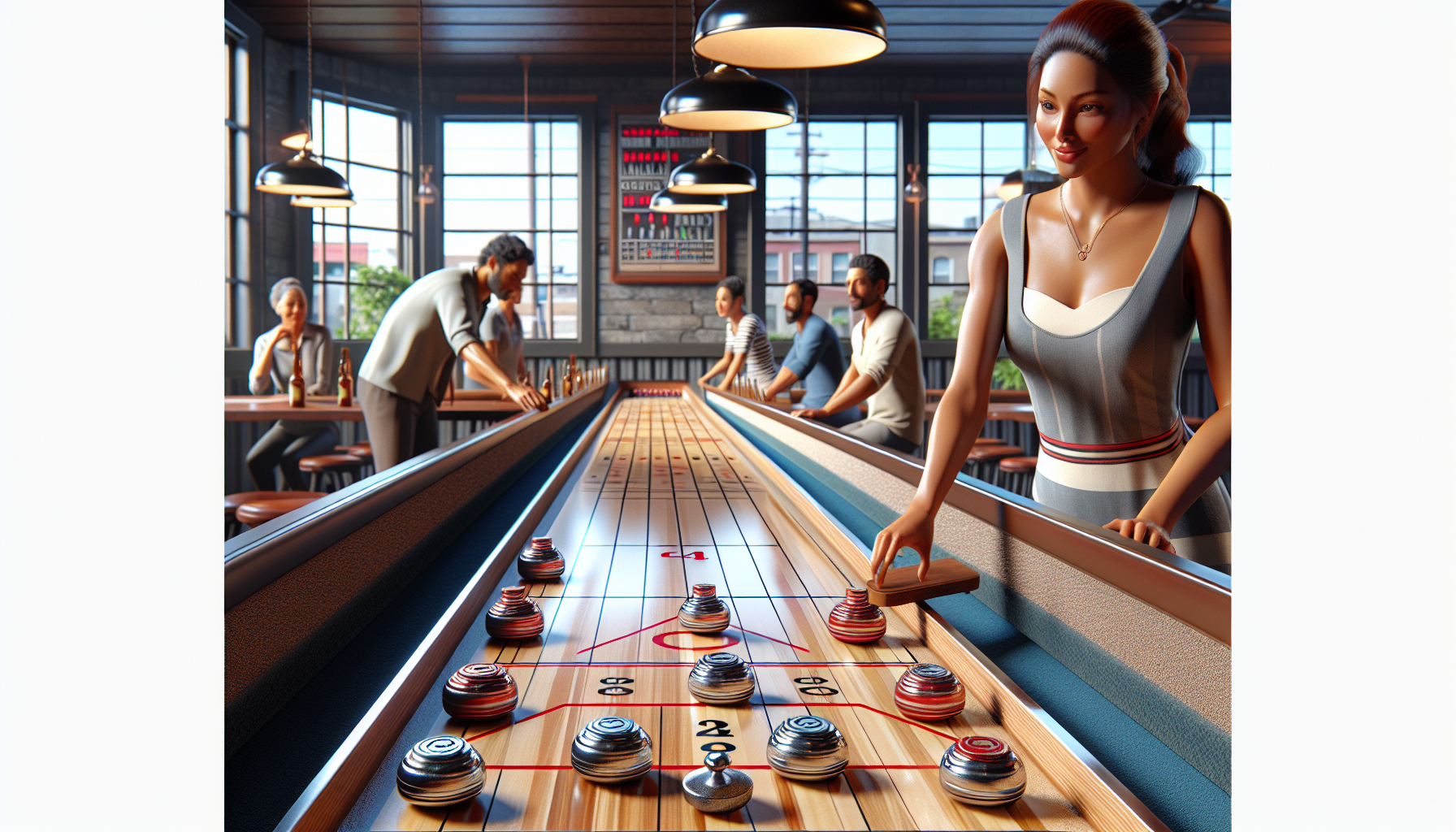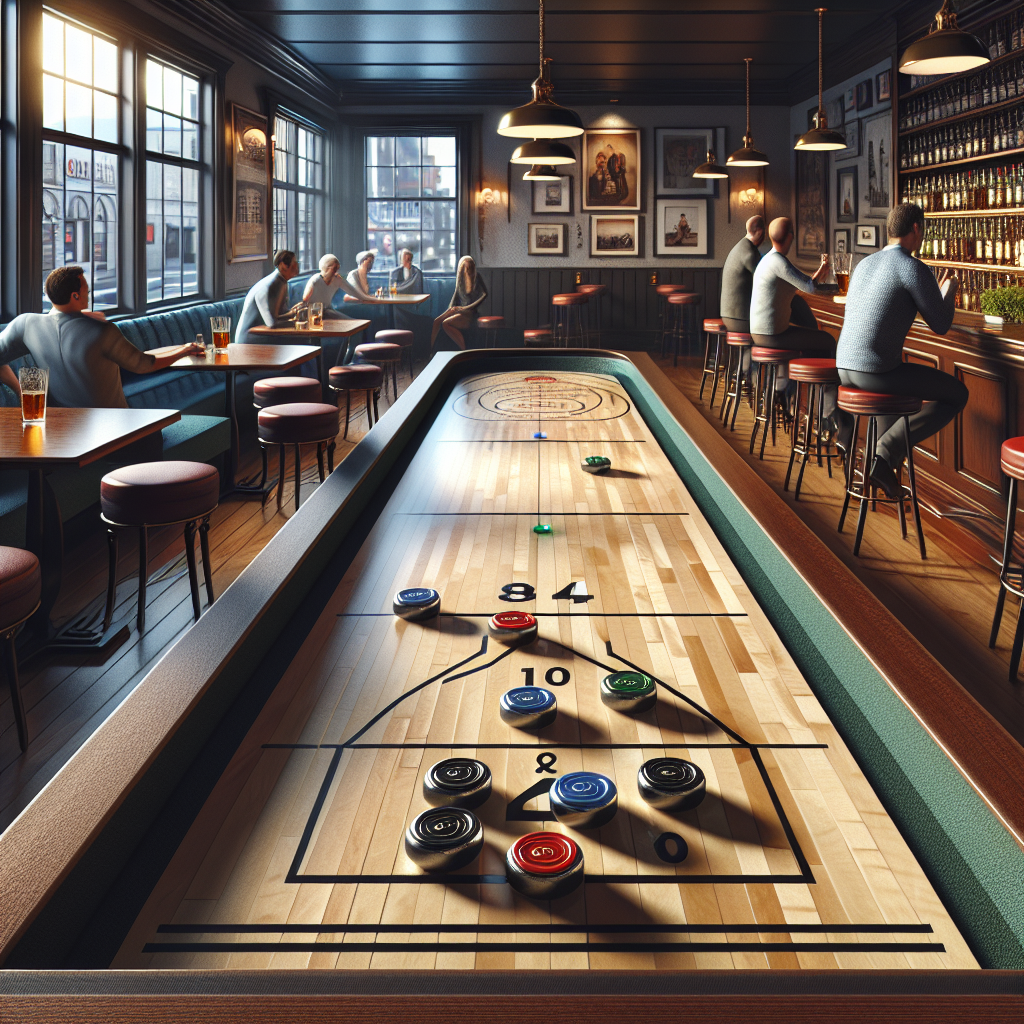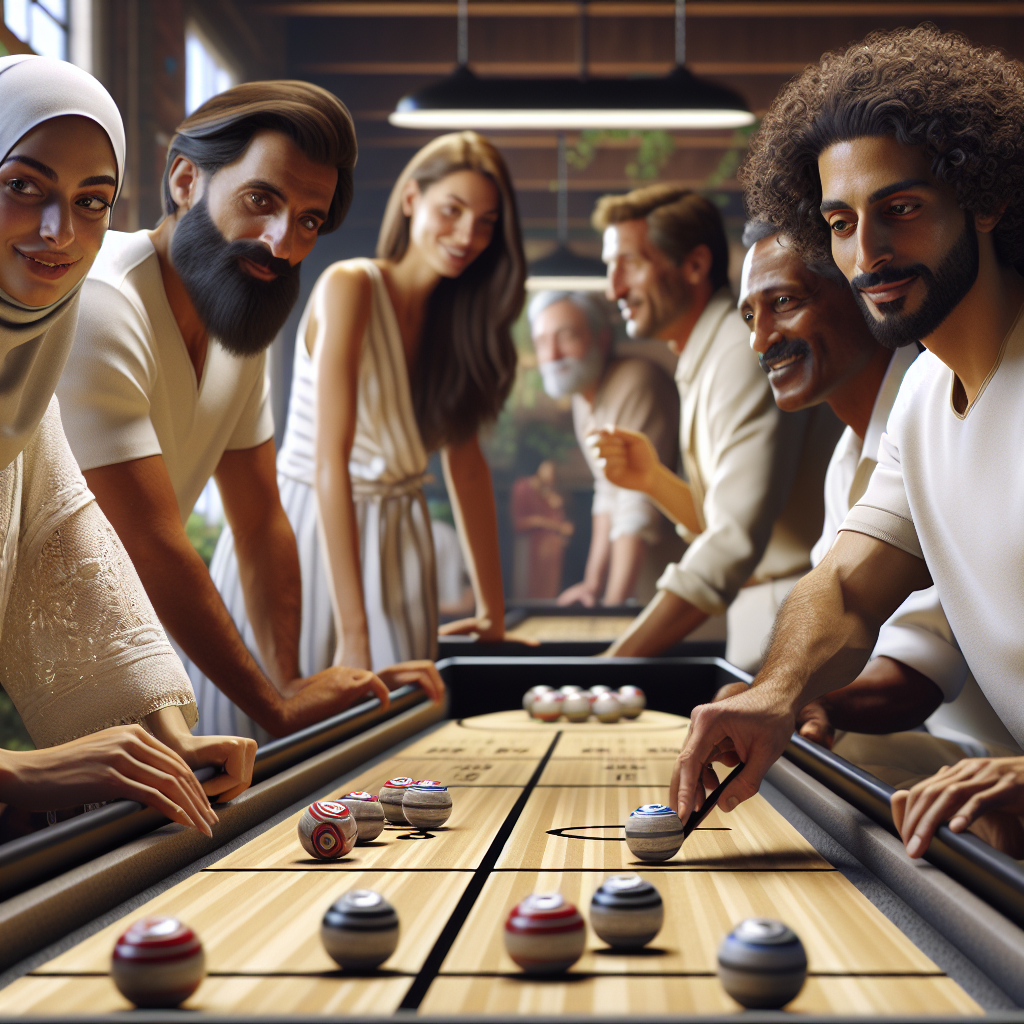Introduction to Bar Shuffleboard
What is Bar Shuffleboard?
Bar shuffleboard, also known as table shuffleboard, is a popular game that combines skill, strategy, and friendly competition. It has gained significant popularity among adults, particularly in bars and game rooms throughout the US (Shuffleboard Planet).
The objective of the game is to slide weighted pucks, known as “weights” or “biscuits,” down a long and narrow table, aiming to land them in scoring zones and outscore your opponent. The smooth playing surface of the shuffleboard table, combined with the strategic gameplay, makes it an enjoyable social activity for players of all skill levels.
Popularity of Bar Shuffleboard
Bar shuffleboard has experienced a resurgence in popularity, attracting a younger crowd seeking interactive entertainment. It has become a staple in bars and game rooms, creating a vibrant and engaging atmosphere for social gatherings. The appeal of bar shuffleboard lies in its combination of skill and strategy, as players compete to outmaneuver their opponents and achieve the highest score.
As a social game, bar shuffleboard provides an opportunity for friendly competition and camaraderie. It encourages players to engage in conversations, cheer each other on, and celebrate victories together. The game’s accessibility and easy-to-understand rules make it appealing to both seasoned players and newcomers alike.
By combining precision, strategy, and a touch of finesse, bar shuffleboard offers a unique and entertaining experience for adults looking to unwind and have fun in a social setting. In the following sections, we will explore the rules, gameplay, strategies, and maintenance tips for bar shuffleboard.
How to Play Bar Shuffleboard
Bar shuffleboard is an engaging and competitive game that can be enjoyed by adults of all skill levels. Whether you’re a beginner or a seasoned player, understanding the objectives, setting up the shuffleboard table, and grasping the basic rules and gameplay is essential to get started.
Objectives of the Game
The objective of bar shuffleboard is to score more points than your opponent by sliding weighted pucks, also known as “weights,” down a long and narrow shuffleboard table. The most common shuffleboard games are usually played to either 15 or 21 points, where players alternately take turns sliding all 4 of their weights down the board to earn points by making it to the highest scoring area without falling off the end of the board.
Setting Up the Shuffleboard Table
Before diving into the gameplay, it’s important to properly set up the shuffleboard table. Bar shuffleboard tables typically have a smooth playing surface made of either wood or synthetic materials. The dimensions of the table may vary, but the standard length ranges from 9 to 22 feet. For more detailed information on the dimensions and setup of the shuffleboard table, refer to our article on bar shuffleboard dimensions.
Basic Rules and Gameplay
To begin the game, players can use a coin toss to determine who goes first. The player who wins the toss has the advantage of the “hammer,” which means they have the final shot of each round.
During their turn, players stand at one end of the shuffleboard table and slide their weights towards the scoring area at the opposite end. The weights must be released from the player’s hand and should not be pushed or carried. Each weight must pass the foul line, which is usually marked on the table, to be considered in play.
The weights can earn points based on their placement on the shuffleboard table. The scoring zones and point values may differ depending on the specific shuffleboard table being used. For a comprehensive understanding of the scoring zones and point values, refer to our article on bar shuffleboard scoring.
To determine the winner, players continue taking turns until a predetermined score is reached, usually 15 or 21 points. The player with the highest score at the end of the game is declared the winner. In the event of a tie, additional rounds or tiebreaker rules may be implemented. For more details on determining the winner and tiebreaker rules, refer to our article on bar shuffleboard rules.
As you become more familiar with the game, you can develop strategies and techniques to improve your performance. These include mastering your grip and stance, judging speed and distance, utilizing different delivery techniques, and engaging in strategic planning. For a deeper dive into these strategies and techniques, explore our article on strategies and techniques for bar shuffleboard.
Now that you have a grasp of how to play bar shuffleboard, it’s time to gather your friends, head to the bar, and enjoy this exciting and social game of skill and strategy.
Strategies and Techniques for Bar Shuffleboard
To excel at bar shuffleboard, players need to develop effective strategies and employ proper techniques. Here are some key aspects to consider:
Grip and Stance
Proper grip and stance are crucial for accuracy and control in shuffleboard. Beginners should ensure a firm but not overly tight grip on the puck, allowing for controlled movement and release. The grip should be adjusted based on personal preference and comfort.
When it comes to stance, maintaining a balanced and stable position is essential. Stand with your feet shoulder-width apart and knees slightly bent to provide a solid foundation. This posture helps to enhance stability and control during the game. For more details, refer to our article on bar shuffleboard rules.
Judging Speed and Distance
Misjudging the speed and distance can lead to missed shots and lost points in shuffleboard. To improve estimation abilities, players should consider various factors, such as the weight of the puck, the force of the push, the texture of the playing surface, and any obstacles that may affect the trajectory of the puck. Practice and experience will help develop a better sense of speed and distance judgment. For more information, check out our article on bar shuffleboard dimensions.
Delivery Techniques
Mastering the proper technique in delivering the puck is essential for success in shuffleboard. Beginners should avoid gripping the puck too tightly, as this can hinder a smooth release. Instead, focus on a relaxed grip that allows for controlled movement. When delivering the puck, maintain a balanced stance with feet shoulder-width apart and weight evenly distributed. This technique ensures stability and accuracy. Explore more about delivery techniques in our article on bar shuffleboard rules.
Strategic Planning
Strategic planning is vital in shuffleboard to outmaneuver opponents and maximize scoring opportunities. Anticipate your opponent’s moves and consider the best placement of your shots to gain an advantage. Control the speed and direction of your shots to achieve desired results. Having a game plan before each match is crucial. Develop a strategic approach that suits your playing style and the specific game situation. For further insights, refer to our article on bar shuffleboard scoring.
By focusing on grip and stance, improving speed and distance judgment, mastering delivery techniques, and implementing strategic planning, players can enhance their performance and enjoy a competitive edge in bar shuffleboard. Regular practice and experience are key to refining these strategies and techniques.
Scoring in Bar Shuffleboard
Scoring is a fundamental aspect of bar shuffleboard, as it determines the progress of the game and ultimately determines the winner. In this section, we will explore the scoring zones and point values, the process of determining the winner, and the rules for tiebreakers.
Scoring Zones and Point Values
The shuffleboard table is divided into different scoring zones, each with its own point values. The zones are typically marked with different colors or numbers to indicate their respective point values. The specific point values may vary depending on the shuffleboard table and the rules being followed.
| Scoring Zone | Point Value |
|---|---|
| 1 | 1 |
| 2 | 2 |
| 3 | 3 |
| 4 | 4 |
Points are awarded based on the position of the shuffleboard weights (also known as pucks) at the end of each round. The scoring areas consist of three zones, and the points are tabulated based on the furthest puck of an individual player relative to the opponent’s pucks. For a detailed understanding of the scoring process, refer to our article on bar shuffleboard scoring.
Determining the Winner
In bar shuffleboard, the objective is to reach a predetermined number of points to win the game. Common point targets are fifteen or twenty-one, but this can be determined prior to the start of the game. The first player to reach the specified point target is declared the winner. For variations of scoring systems that handicap games for players of different skill levels, refer to our article on bar shuffleboard rules.
Tiebreaker Rules
In the event of a tie in bar shuffleboard, certain rules come into play. When determining which player’s puck is closer to the end, an imaginary line perpendicular to the playing surface is drawn to agree on the puck’s position. If a tie occurs, no points are awarded. It’s also important to note that points only count if the pucks are not touching the boundary lines. For example, if a puck is positioned between two scoring zones, it will only be counted as belonging to the lower-value zone. For more information on tiebreaker rules and additional gameplay scenarios, please refer to our comprehensive article on bar shuffleboard rules.
Understanding the scoring system in bar shuffleboard is essential for enjoying the game and determining the winner. By familiarizing yourself with the scoring zones, point values, and tiebreaker rules, you can confidently compete in bar shuffleboard and aim for victory.
Maintaining and Enhancing Shuffleboard Tables
To keep your shuffleboard table in optimal condition and ensure smooth gameplay, regular maintenance is essential. This section will cover three key aspects of maintaining and enhancing shuffleboard tables: checking table level and concavity, applying shuffleboard sand, and waxing and regular maintenance.
Checking Table Level and Concavity
An important consideration when setting up a shuffleboard table is to ensure that it is properly adjusted. To check this, you can use a level across the width of the table’s surface to ensure it is level. Adjusting the nuts on the climate adjusters can help achieve the right level of concavity to prevent pucks from flying off while ensuring fair gameplay (Shuffleboard Planet).
It is recommended to check the level and concavity of the shuffleboard table whenever there are changes in temperature or humidity. This helps in maintaining the table’s playability despite wood expansion or contraction due to climate shifts (Shuffleboard Planet).
Applying Shuffleboard Sand
Shuffleboard sand, also known as shuffleboard wax or shuffleboard powder, is essential for ensuring the pucks glide down the table correctly and helps preserve the shuffleboard table. It is a silicone-based powder that is key to the longevity and maintenance of the shuffleboard table (HB Home Furnishings).
To apply shuffleboard sand, start by cleaning the table surface thoroughly to remove any dirt or debris. Next, sprinkle the shuffleboard sand evenly across the table, using a shuffleboard sand applicator or a wax spreader. Spread the sand in a straight line along the length of the table. Gently sweep the excess sand into the gutters or collection areas. Repeat this process periodically to ensure optimal gameplay and proper puck sliding.
Waxing and Regular Maintenance
To maintain a shuffleboard table, when you notice pucks not sliding swiftly, apply a silicone-based lubricant evenly across the entire surface using long sweeping motions. After drying a bit, buff it with a clean rag. Subsequently, sprinkle shuffleboard wax liberally over the surface to ensure smooth gameplay. Regular waxing can reduce the frequency of maintenance.
For best results in maintaining a shuffleboard table, it is ideal to re-wax the table every few times it is played. In a professional setting like a bar, where frequent re-waxing may not be possible, waxing at the end of the night after closing can help keep the table in good condition (Shuffleboard Planet).
Regular maintenance also includes cleaning the table surface with a damp cloth to remove any residue or spills. Avoid using harsh chemicals or abrasive cleaners, as they can damage the table’s finish. Additionally, inspect the table for any signs of wear or damage, such as loose screws or chipped edges, and address them promptly to maintain the table’s integrity.
By following these maintenance practices, you can ensure that your shuffleboard table remains in excellent condition, providing endless hours of enjoyment for both casual players and enthusiasts alike.
Scoring in Bar Shuffleboard
To fully enjoy and compete in a game of bar shuffleboard, understanding the scoring system is crucial. The game involves scoring zones, determining points, and strategies to outscore opponents. Let’s explore how scoring works in bar shuffleboard.
Scoring Zones and Point Values
The shuffleboard table is divided into scoring zones that are worth different point values. The most common shuffleboard games are usually played to either 15 or 21 points, where players alternately take turns sliding all 4 of their weights down the board to earn points by making it to the highest scoring area without falling off the end of the board (McClure Tables). Here is a breakdown of the scoring zones and their respective point values:
| Scoring Zone | Point Value |
|---|---|
| 1 | 1 |
| 2 | 2 |
| 3 | 3 |
| 4 | 4 |
| 5 | 5 |
| 10 Off | 10 |
| 10 Plus | 10 |
The scoring zones are numbered from 1 to 4, with the 1-point zone closest to the edge of the table. The 10 Off and 10 Plus zones are located at the end of the table, where the weights can fall off (bar shuffleboard rules). Understanding the point values assigned to each zone is essential for players to strategize their shots effectively.
Determining the Winner
To determine the winner, players continue taking turns until one of them reaches the predetermined point total (usually 15 or 21). The player with the highest score at the end of the game wins. However, there is a twist – if a player exceeds the predetermined point total, their score is reduced back to their opponent’s score. This rule prevents a player from winning by a large margin and ensures a more competitive and engaging game (bar shuffleboard rules).
Tiebreaker Rules
In the event of a tie at the end of the game, tiebreaker rules come into play. Depending on the specific bar or establishment, tiebreakers can be determined by different methods such as a sudden-death round, additional rounds with reduced scoring zones, or an agreed-upon tiebreaker rule among the players. It’s important to clarify the tiebreaker rules before starting the game to avoid any confusion or disputes.
Understanding the scoring system in bar shuffleboard is essential for players to develop effective strategies and aim for victory. By aiming for the higher-scoring zones and preventing opponents from scoring in those areas, players can gain an advantage and increase their chances of winning. So, keep these scoring rules in mind and aim for those high-scoring zones to shuffle your way to victory.








